Topics
Category
Era
Cloquet, Duluth, and Moose Lake Fires, 1918
The worst natural disaster in Minnesota history—over 450 dead, fifteen hundred square miles consumed, towns and villages burned flat—unfolded at a frightening pace, lasting less than fifteen hours from beginning to end. The fire began around midday on Saturday, October 12, 1918. By 3:00 a.m. on Sunday, all was over but the smoldering, the suffering, and the recovery.
What is often called simply the Cloquet Fire was really a host of fires, fifty or more, that combined in a single event. It had two major theaters, one called the Cloquet–Duluth Fire and the other the Moose Lake Fire.
Conditions for both had been building for months. Lumbering, the region’s main industry, created giant depots of cut, dry lumber and left the countryside littered with wood waste. Farmers routinely burned fields and brush. Locomotives, contrary to law, spewed sparks and embers. The summer and fall of 1918 had been extremely dry.
The Cloquet–Duluth Fire began before noon on October 10 when a Great Northern locomotive set a small fire at Milepost 62 northwest of Cloquet. It smoldered for two days, then came alive when a cold front brought stiff winds and a steep drop in humidity. At about 1:30 p.m. this fire began to move and join with others.
It moved on two axes: east toward Duluth and southeast toward Cloquet. Around 2:00 p.m. the Cloquet-bound fire destroyed the village of Brookston. Moving slowly at first, it reached the Fond du Lac Ojibwe reservation around 7:15 and the city of Cloquet around 8:00.
Winds had by then risen to sixty miles per hour. Later, survivors described phenomena of terror: walls of flame hundreds of feet tall, houses exploding from heat, bolts of flaming wood propelled through the air, the sun turned red, and a roar louder than thunder.
The people of Cloquet got just enough warning. Factory whistles blew, the fire department sent runners, telephone operators called every number, and the mayor organized four evacuation trains. The city, full of frame houses and tons of dry lumber at three sawmills, burned almost flat. But only five people died there; over seven thousand got out by train.
The Duluth-bound fire crept east from Milepost 62, joined with another fire around 2:00 p.m., and then began to dash. Winds rose to hurricane force, pushing forward the fire’s front, ten miles wide, at up to twenty miles per hour. The world’s fastest sprinter, given a one-hundred-yard head start, would have been in flames within thirty seconds. For people caught in the inferno’s path, survival often depended on luck.
The fire reached the northeastern corner of Duluth around 7:00 p.m. It burned a country club and train depot but never descended into the main part of the city. Winds began to fall around 9:00 p.m. By 3:00 a.m. the fire had reached its limit at Lake Superior; around eight hundred square miles had been charred.
The Moose Lake fire—at least five fires combined—had begun October 4 along railroad tracks near Tamarack in Aitkin County, then lain low until the winds and humidity drop of October 12 whipped it into motion at about 1:00 p.m. that day. It drove southeast toward the towns of Kettle River and Moose Lake, combining with other fires along the way. Twenty-five people in the village of Automba were killed when the flames raced through, destroying it completely.
The fire reached Kettle River around 6:45. Seventy-five to one hundred people, some of them fleeing by car, were killed by fire and an accident at a sharp highway turn south of town called Dead Man’s Curve. People could not outrun the racing flames. They saved themselves in streams, ditches, and open fields, or died, many in root cellars by suffocation.
As the blaze neared Moose Lake around 7:30, relief trains rescued a few hundred. Most who survived, however, did so by taking refuge in Moose Head Lake. Some simply drove their cars in and waited. By 10:00 p.m. the fire had passed. The Moose Lake Fire consumed over four hundred square miles and caused more than half of that day’s deaths. Other fires added to the destruction and tally of victims.
A statewide relief effort, assisted in part by the Minnesota Home Guard, began October 13. Rebuilding followed soon thereafter.
Bibliography
Carroll, Francis M., and Franklin R. Raiter. The Fires of Autumn, the Cloquet-Moose Lake Disaster of 1918. St. Paul: Minnesota Historical Society, 1990.
Minnesota Forest Fires Relief Commission. Final Report of Minnesota Forest Fires Relief Commission. Duluth, MN: N.p., 1921.
Richardson, H.W. “The Northeastern Minnesota Forest Fires of October 12, 1918.” Geographical Review 7 no. 4 (April 1919): 220–232.
Skalko, Christine, and Marlene Wisuri. Fire Storm: The Great Fires of 1918. Cloquet, MN: Carlton County Historical Society 2003.
Related Resources
Primary
Administrative files, miscellaneous, [c.1910]–1969
Minnesota Conservation Department. Division of Forestry
State Archives Collection, Minnesota Historical Society, St. Paul
http://www2.mnhs.org/library/findaids/cons060.pdf
Description: See, "The Great Minnesota Fire" by John McClaren. McClaren was in Duluth during the 1918 fire and volunteered in the relief efforts in Duluth, Cloquet, and Moose Lake.
Anderson v. Minneapolis, St. Paul, & Sault St. Marie Railway, 146 Minn. 430 (1920).
“At Least 1,000 Persons Perish in Forest Fires.” White Earth Tomahawk, October 24, 1918.
http://chroniclingamerica.loc.gov/lccn/sn89064695/1918-10-24/ed-1/seq-7/
“Bemidji Rallying to Relief of Fire Victims; ‘Pioneer Fund is Growing.” Bemidji Daily Pioneer, October 17, 1918.
http://chroniclingamerica.loc.gov/lccn/sn86063381/1918-10-17/ed-1/seq-1/
Borsheim v. Great Northern, 149 Minn. 210 (1921).
P2809
Cloquet Fire Witness Statements and Correspondence, 1918–1921
Manuscript Collection, Minnesota Historical Society, St. Paul
Description: Witness statement concerning the Cloquet fire of 1918.
“Fire Fighters Are Being Kept Busy.” Little Falls Herald, October 18, 1918.
http://chroniclingamerica.loc.gov/lccn/sn89064515/1918-10-18/ed-1/seq-4/
McKenzie, Hugh, and Olaf Olson. "Awful Destruction by Forest Fires in Northern Minnesota, Oct. 12–15, 1918." Photographic postcards album. Duluth, MN: Huntley-Burnett Printing, 1919.
Editor’s note: Available at the Minnesota History Center’s Gale Family Library under the call number SD421.32.M6 A93 1918.
Minnesota Forest Fire Reimbursement Association. A Brief Statement of Facts: Minnesota Forest Fires, 1918. Cloquet, MN: Northern Printery Press, [1925].
OH 142
Oral history interview with Carl Bruno, September 30, 1975
Oral History Collection, Minnesota Historical Society, St. Paul
http://collections.mnhs.org/cms/display.php?irn=11124687
Description: In this interview, Carl Bruno recounts the fire of 1918.
OH 142
Oral history interview with Tina Smith, October 9, 1975
Oral History Collection, Minnesota Historical Society, St. Paul
Tina Smith: http://collections.mnhs.org/cms/display.php?irn=11124757
Description: In this interview, Tina Smith recounts the fire of 1918.
“Over 6000 Bodies, Estimated, Recovered.” Bemidji Daily Pioneer, October 14, 1918.
http://chroniclingamerica.loc.gov/lccn/sn86063381/1918-10-14/ed-1/seq-1/
P939
Reminiscences of Iva Andrus Dingwall, 1953–1954
Manuscript Collection, Minnesota Historical Society, St. Paul
Description: Dingwall reminiscences about Superior, Wisconsin, and providing aid to survivors of the 1918 fires.
“State Forester Makes Statement on Forest Fires.” Grand Marais Cook County News-Herald, November 13, 1918.
http://chroniclingamerica.loc.gov/lccn/sn83016544/1918-11-13/ed-1/seq-4/
P1193-4
The 1918 Cloquet Fire, 1980 March 29
Manuscript Collection, Minnesota Historical Society, St. Paul
Description: Typescript reminiscence by a witness of the 1918 fires.
The 1918 Fire in Eastern Aitkin County: Personal Accounts of Survivors. [MN: N.p., 1970].
Secondary
Brown, Curt. Minnesota 1918: When Flu, Fire, and War Ravaged the State. St. Paul: Minnesota Historical Society, 2018.
Cloquet Public Library. Awfullest Fire Horror in State’s History. Cloquet, MN: The Library, [1977].
“Fire! Minnesota Tragedy.” Potlatch Story 23, no. 1 (June 1983).
The Fury of the Flames: A Pictorial Record of the Great Forest Fires Which Rages in Northern Minnesota, Oct. 12–15, 1918. [Duluth, MN: M.A. Olmem, 1919].
Lambert, Carol Illikainen. Firebeast: The Fires of 1918. Moose Lake, MN: Moose Lake Area Historical Society, 1994.
Luukkonen, Arnold L. “Brave Men in Their Motor Machines and the 1918 Forest Fire.” Ramsey County History 9, no. 2 (Fall 1972): 3–8.
Maxham, Glen. The Fires of 1918. VHS. Duluth, MN: WDSE-TV, 1981.
Moose Lake Area Historical Society, comp. 1918 Fire Stories. Moose Lake, MN: The Society, 2003.
Olson, Marie E. Saved Through Fire: Experiences and Applications From the Fire of Cloquet, Minn., U.S.A., October 12, 1918. [MN?: the author, 1934].
Panger, Alicia. “I remember the Great Fire: Our Lives Were Not Among the 608 Lost.” Catholic Digest, 1964.
Sommer, Barbara. Cloquet and the Fires of 1918: The City that Really Came Back. [Cloquet, MN]: Carlton County Historical Society, 1985.
Related Audio
MN90: Minnesota's Massive Fire of 1918
All rights reserved
More Information
Related Images
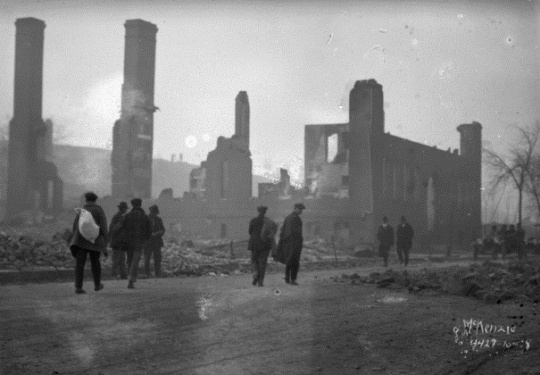
People and ruins after the fire
Public domain
Holding Location
More Information
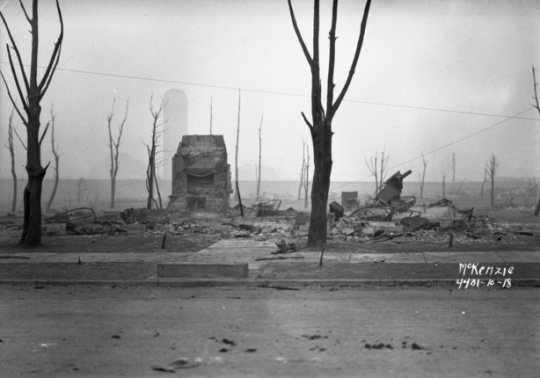
Building ruins, Cloquet
Public domain
Holding Location
More Information
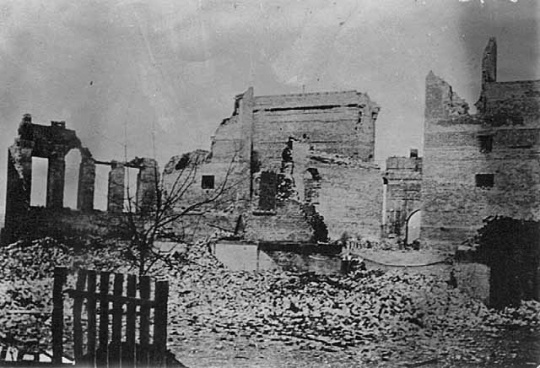
Scene after the fire, Cloquet
Public domain
Holding Location
More Information
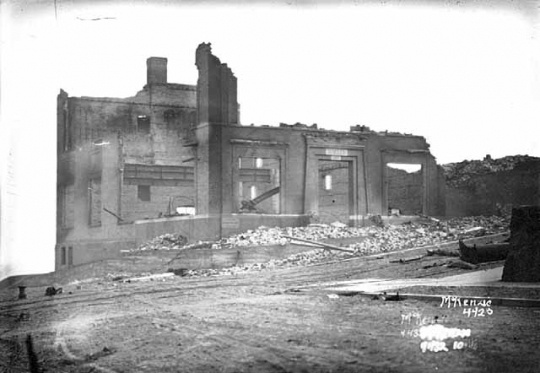
Ruins of Masonic Temple, Cloquet
Public domain
Holding Location
More Information
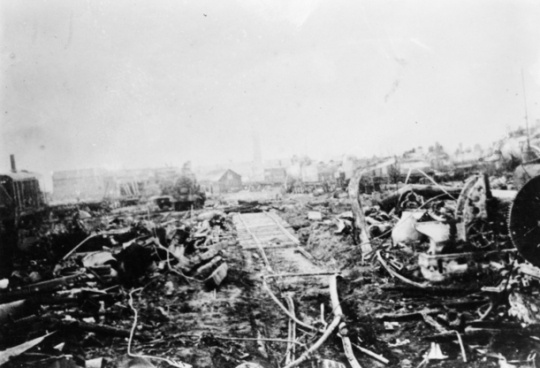
Duluth & Northeastern Railroad yards after the fire
Public domain
Holding Location
More Information
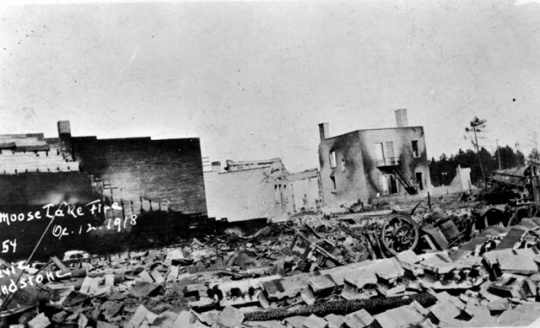
Street view after fire, Moose Lake
Public domain
Holding Location
More Information
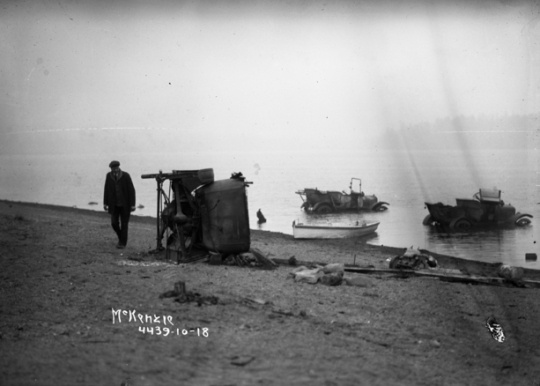
Automobiles in Moose Lake after fire
Public domain
Holding Location
More Information
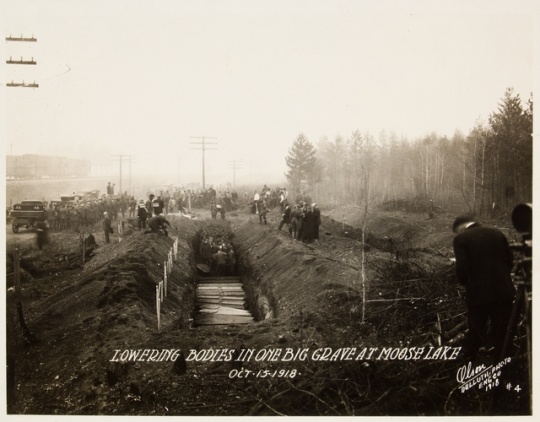
Mass grave at Moose Lake
Public domain
Holding Location
More Information
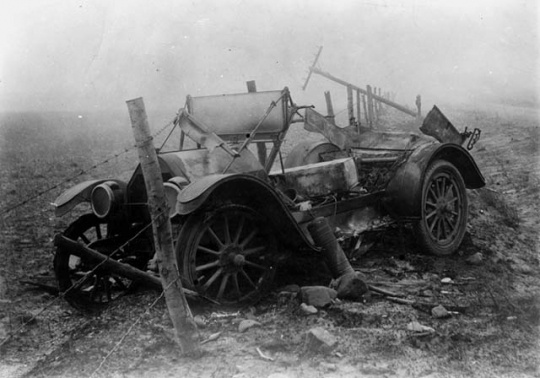
Ruins of car after fire
Public domain
Holding Location
More Information
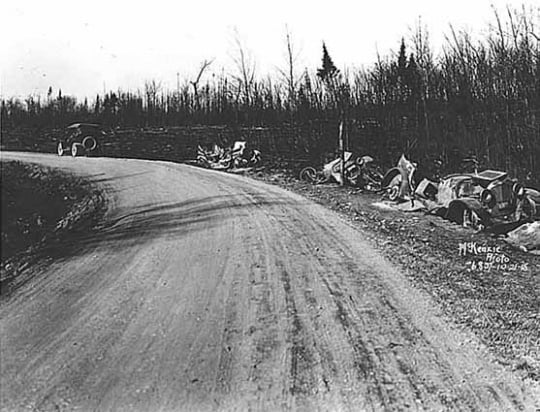
Wrecked cars along Pike Lake Road near Duluth
Public domain
Holding Location
More Information
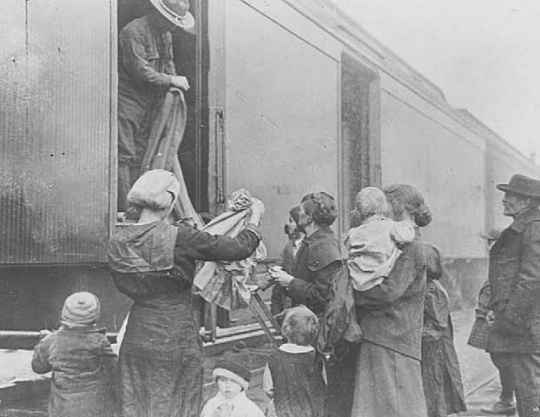
National Guard giving out clothing
Public domain
Holding Location
More Information
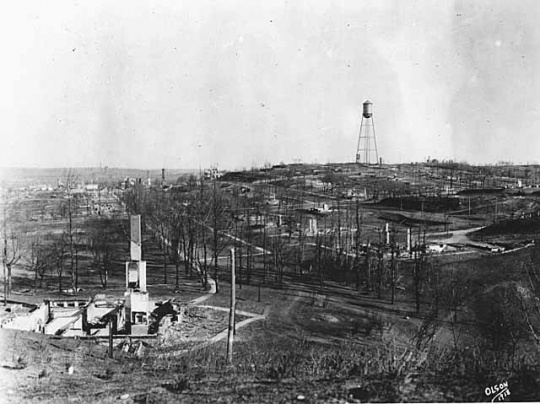
View of Cloquet after fire
Public domain
Holding Location
More Information
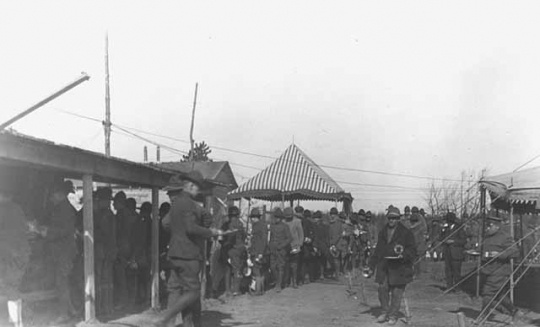
Refugees and relief workers after the Moose Lake fire
Public domain
Holding Location
More Information
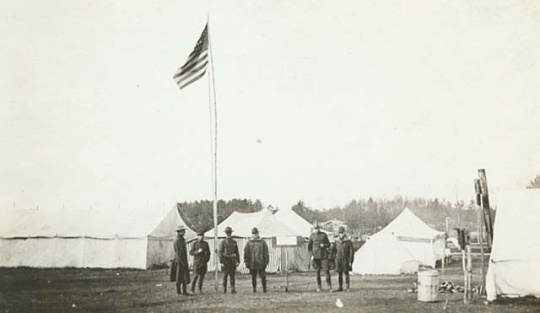
Minnesota Home Guard camp providing assistance
Public domain
Holding Location
More Information

Minnesota Home Guard digging graves with Governor Burnquist
Public domain
Holding Location
More Information
Related Articles
Turning Point
On October 12, 1918, high winds from the west and a sudden drop in humidity turn scattered, small, and harmless fires into a fire storm.
Chronology
1916
1918
1918
1918
October 12, 3:30 p.m.
October 12, 4:00 p.m.
October 12, 6:15 p.m.
October 12, 7:00 p.m.
October 12, 7:30 p.m.
October 12, 8:00 p.m.
October 12, 10:00 p.m.
October 13, 3:00 a.m.
October 16, 1918
October 19, 1918
1935
Bibliography
Carroll, Francis M., and Franklin R. Raiter. The Fires of Autumn, the Cloquet-Moose Lake Disaster of 1918. St. Paul: Minnesota Historical Society, 1990.
Minnesota Forest Fires Relief Commission. Final Report of Minnesota Forest Fires Relief Commission. Duluth, MN: N.p., 1921.
Richardson, H.W. “The Northeastern Minnesota Forest Fires of October 12, 1918.” Geographical Review 7 no. 4 (April 1919): 220–232.
Skalko, Christine, and Marlene Wisuri. Fire Storm: The Great Fires of 1918. Cloquet, MN: Carlton County Historical Society 2003.
Related Resources
Primary
Administrative files, miscellaneous, [c.1910]–1969
Minnesota Conservation Department. Division of Forestry
State Archives Collection, Minnesota Historical Society, St. Paul
http://www2.mnhs.org/library/findaids/cons060.pdf
Description: See, "The Great Minnesota Fire" by John McClaren. McClaren was in Duluth during the 1918 fire and volunteered in the relief efforts in Duluth, Cloquet, and Moose Lake.
Anderson v. Minneapolis, St. Paul, & Sault St. Marie Railway, 146 Minn. 430 (1920).
“At Least 1,000 Persons Perish in Forest Fires.” White Earth Tomahawk, October 24, 1918.
http://chroniclingamerica.loc.gov/lccn/sn89064695/1918-10-24/ed-1/seq-7/
“Bemidji Rallying to Relief of Fire Victims; ‘Pioneer Fund is Growing.” Bemidji Daily Pioneer, October 17, 1918.
http://chroniclingamerica.loc.gov/lccn/sn86063381/1918-10-17/ed-1/seq-1/
Borsheim v. Great Northern, 149 Minn. 210 (1921).
P2809
Cloquet Fire Witness Statements and Correspondence, 1918–1921
Manuscript Collection, Minnesota Historical Society, St. Paul
Description: Witness statement concerning the Cloquet fire of 1918.
“Fire Fighters Are Being Kept Busy.” Little Falls Herald, October 18, 1918.
http://chroniclingamerica.loc.gov/lccn/sn89064515/1918-10-18/ed-1/seq-4/
McKenzie, Hugh, and Olaf Olson. "Awful Destruction by Forest Fires in Northern Minnesota, Oct. 12–15, 1918." Photographic postcards album. Duluth, MN: Huntley-Burnett Printing, 1919.
Editor’s note: Available at the Minnesota History Center’s Gale Family Library under the call number SD421.32.M6 A93 1918.
Minnesota Forest Fire Reimbursement Association. A Brief Statement of Facts: Minnesota Forest Fires, 1918. Cloquet, MN: Northern Printery Press, [1925].
OH 142
Oral history interview with Carl Bruno, September 30, 1975
Oral History Collection, Minnesota Historical Society, St. Paul
http://collections.mnhs.org/cms/display.php?irn=11124687
Description: In this interview, Carl Bruno recounts the fire of 1918.
OH 142
Oral history interview with Tina Smith, October 9, 1975
Oral History Collection, Minnesota Historical Society, St. Paul
Tina Smith: http://collections.mnhs.org/cms/display.php?irn=11124757
Description: In this interview, Tina Smith recounts the fire of 1918.
“Over 6000 Bodies, Estimated, Recovered.” Bemidji Daily Pioneer, October 14, 1918.
http://chroniclingamerica.loc.gov/lccn/sn86063381/1918-10-14/ed-1/seq-1/
P939
Reminiscences of Iva Andrus Dingwall, 1953–1954
Manuscript Collection, Minnesota Historical Society, St. Paul
Description: Dingwall reminiscences about Superior, Wisconsin, and providing aid to survivors of the 1918 fires.
“State Forester Makes Statement on Forest Fires.” Grand Marais Cook County News-Herald, November 13, 1918.
http://chroniclingamerica.loc.gov/lccn/sn83016544/1918-11-13/ed-1/seq-4/
P1193-4
The 1918 Cloquet Fire, 1980 March 29
Manuscript Collection, Minnesota Historical Society, St. Paul
Description: Typescript reminiscence by a witness of the 1918 fires.
The 1918 Fire in Eastern Aitkin County: Personal Accounts of Survivors. [MN: N.p., 1970].
Secondary
Brown, Curt. Minnesota 1918: When Flu, Fire, and War Ravaged the State. St. Paul: Minnesota Historical Society, 2018.
Cloquet Public Library. Awfullest Fire Horror in State’s History. Cloquet, MN: The Library, [1977].
“Fire! Minnesota Tragedy.” Potlatch Story 23, no. 1 (June 1983).
The Fury of the Flames: A Pictorial Record of the Great Forest Fires Which Rages in Northern Minnesota, Oct. 12–15, 1918. [Duluth, MN: M.A. Olmem, 1919].
Lambert, Carol Illikainen. Firebeast: The Fires of 1918. Moose Lake, MN: Moose Lake Area Historical Society, 1994.
Luukkonen, Arnold L. “Brave Men in Their Motor Machines and the 1918 Forest Fire.” Ramsey County History 9, no. 2 (Fall 1972): 3–8.
Maxham, Glen. The Fires of 1918. VHS. Duluth, MN: WDSE-TV, 1981.
Moose Lake Area Historical Society, comp. 1918 Fire Stories. Moose Lake, MN: The Society, 2003.
Olson, Marie E. Saved Through Fire: Experiences and Applications From the Fire of Cloquet, Minn., U.S.A., October 12, 1918. [MN?: the author, 1934].
Panger, Alicia. “I remember the Great Fire: Our Lives Were Not Among the 608 Lost.” Catholic Digest, 1964.
Sommer, Barbara. Cloquet and the Fires of 1918: The City that Really Came Back. [Cloquet, MN]: Carlton County Historical Society, 1985.
















